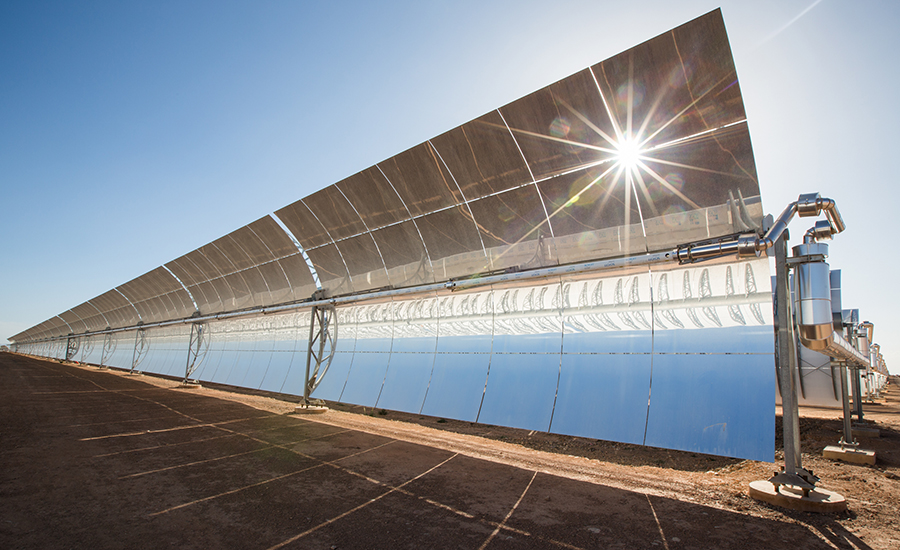Morocco Delays Inauguration of Concentrated Solar Plant
Scheduling delays with dignitaries blamed

Noor-I's 537,600 solar-tracking parabolic mirrors stand poised in the Moroccan desert to begin converting concentrated solar energy into heat, and then electricity through steam generation. Scheduling problems with dignitaries to inaugurate the system reportedly are causing a start-up delay.
Photo courtesy of ACWA Power
Morocco has abruptly delayed the scheduled inauguration of Noor-I CSP, a $600-million, 160-MW concentrated solar powerplant scheduled for start-up on Dec. 27.
Noor-I is the first of three plants being built at Ouarzazate, 200 km south of Marrakech city, by ACWA Power International, a subsidiary of Riyadh-based ACWA Holding. CSP systems concentrate solar rays with mirrors or lenses. The three plants at Ouarzazate will incorporate different types of solar technologies and, taken together, should have a capacity of 510 MW and create the world’s largest CSP park when complete. A fourth phase in discussion will use photovoltaic technology.
ACWA Power has a build-own-operate-transfer contract to develop the plants. ACWA spokesperson Jon Barber said, in an email response to inquiries, that Noor-I is finished and ready to start harvesting power. The delay “is purely of the inauguration ceremony,” he said, adding that the Moroccan Agency for Solar Energy (MASEN) is working on finding a new date.
“With so many very senior people anticipated, it was not possible to make the date happen and the inauguration has simply been moved to a new date–which is yet to be confirmed by MASEN,” said Barber. “No need to read any more into it than that,” Barber added, saying that the full program of work on the trio of plants “continues to move forward at the same pace.”
ACWA Power partnered with Madrid-based Aries Ingeniería y Sistemas and TSK Group’s subsidiary TSK Flagsol to develop the SENERtrough parabolic troughs that comprise the facility’s 537,600 annealed mirrors, which are produced by ACWA Holding’s subsidiary Flabeg FE GmBH. The mirrors track the sun in the desert region and direct the rays into an absorber pipe containing DOWTHERM, a heat transfer fluid supplied by the Michigan-based Dow Chemicals. The heat is transferred into water, which releases steam to drive turbines that will generate a gross of 160 MW and net of 143 MW of electricity.
According to a project brief, the transfer fluid’s “molten salts” will hold the heat and allow power generation at full capacity for three hours, even when there is no solar radiation. The plant has a light-fuel-oil boiler for back up.
The system’s water supply comes from the El Mansour Eddahbi dam on the 1100-km-long Draa River, 12 km away. The dam has an impoundment capacity of about 560 million cubic meters. The three CSP plants at Ouarzazate solar park will consume an estimated 2.5 to 3 million cu m of water annually. Additional water storage reservoirs with total capacity of 300,000 cu m also are under construction “to ensure safety of the plants’ cooling systems,” according to the MASEN project brief.
Construction, under an engineer-procure-construct contract by Spanish consortium TSK-Acciona-Sener commenced in 2013, a year after the signing of a power purchase agreement between MASEN and the ACWA Power-led consortium.
The electricity generated from Noor-I will be delivered to the grid through a 225/60 kV station adjacent to the project site. Additional stations are planned before the anticipated commissioning of Noor-II in the first quarter of 2017 and Noor-III in the first quarter of 2018.
Morocco hopes the project will help it meet its target of a 92% reduction in CO2 emissions through the nation’s internationally-supported 2000MW Solar Plan. The World Bank, one of the financiers of the three plants, says Morocco should realize CO2 savings of 240,000 tonnes/year when Noor-I comes online with additional savings of about 521,670 tonnes/year after the 200MW Noor-II and 150MW Noor-III are commissioned. ACWA Power has a greater than 70% stake in Noor II and Noor III.
The World Bank says “over the 25-year lifetime of the CSP plants, the cumulative emissions reduction of CO2 is an estimated 6 million tonnes for the 160 MW first tranche, [and] 13 million for Noor II & III, corresponding to 19 million tonnes for the 510 MW Noor Solar Complex.”
Morocco is the largest energy importer in Middle East and North Africa region. It gets up to 97% of its energy from fossil fuel. MASEN is also developing 2000 MW each from wind and hydro sources within the same period. Through its 2000 MW Solar Plan, Morocco hopes to increase the share of renewable energy in its energy mix to at least 42% by 2020.
Aside from the World Bank, lenders partnering to finance Morocco’s Solar Plan include the African Development Bank, European Investment Bank, l’Agence Française de Développement, Kreditanstalt fuer Wiederaufbau and the European Commission.
Electricity from the Noor-I CSP will be supplied to MASEN which will sell it to Morocco’s monopoly power purchaser, Office National de I’Electricite et de I’Eau Potable. -



